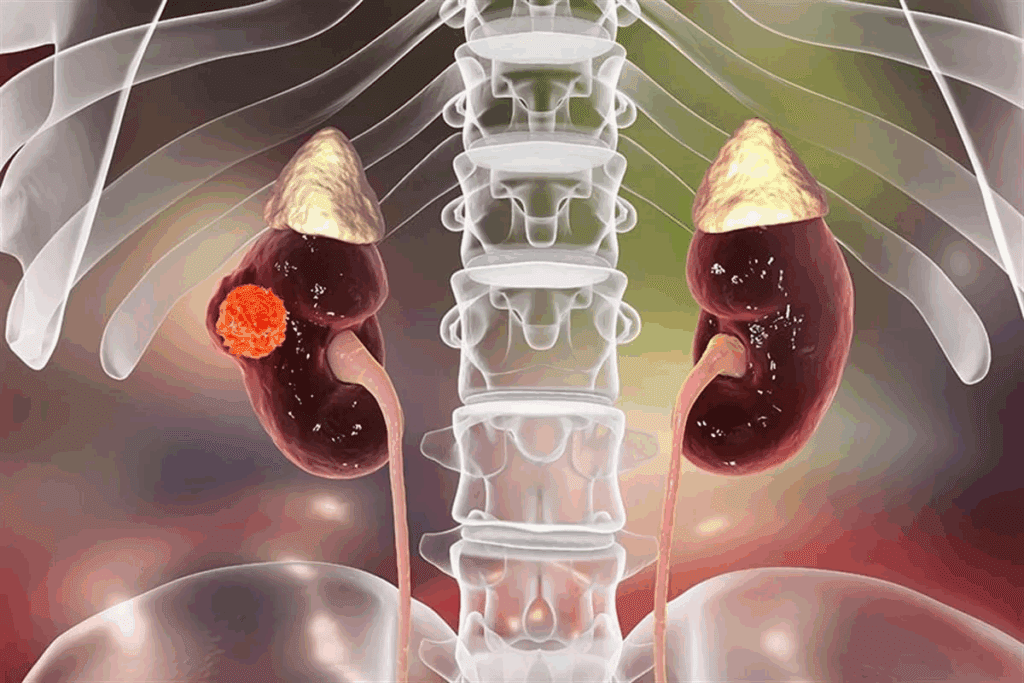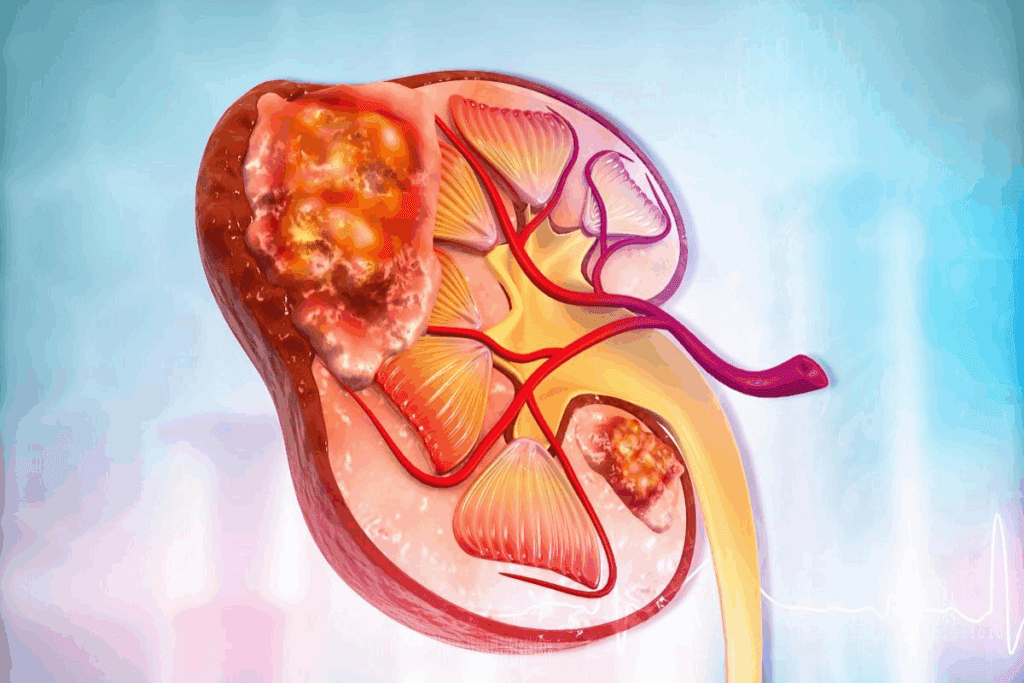Last Updated on November 26, 2025 by Bilal Hasdemir
For those looking into new treatments for kidney cancer, knowing about cryoablation is key. Liv Hospital, known for its focus on patients, talks about the good points of this method. It uses very cold temperatures to kill cancerous tissue, giving a surgery-free option for some patients.

This method puts extreme cold right on cancer cells to kill them. It’s chosen when surgery isn’t possible, making it a good choice for some kidney cancer cases. It keeps the healthy tissue around the kidney safe, showing a big step forward in treating kidney cancer.
Key Takeaways
- Cryoablation is a minimally invasive treatment using extreme cold to destroy cancerous tissue.
- It is considered for patients who are not ideal candidates for surgery.
- The procedure preserves surrounding healthy tissue in the kidney.
- Cryoablation is a viable option for treating renal cell carcinoma.
- Liv Hospital offers internationally recognized care for kidney cancer patients.
Understanding Kidney Cancer: A Brief Overview
To understand why cryoablation is key in treating kidney cancer, we must first know about the disease. Kidney cancer, or renal cancer, starts in the kidneys. These organs are vital for filtering waste and controlling body functions.
Types and Prevalence of Kidney Cancer
The most common kidney cancer in adults is Renal Cell Carcinoma (RCC). It makes up about 85 to 90% of cases. RCC comes from the cells lining the kidney’s tubules. The American Cancer Society says RCC is among the top 10 cancers for both men and women.
Kidney cancer cases are going up every year. This rise is due to more risk factors like obesity and high blood pressure. Also, better imaging tools help find more cases.
Risk Factors and Early Detection
Several factors increase the chance of getting kidney cancer. These include:
- Smoking
- Obesity
- Hypertension
- Family history of kidney cancer
- Certain genetic conditions, such as von Hippel-Lindau disease
Finding kidney cancer early is hard because symptoms often show up late. But, more cancers are caught early thanks to better imaging like CT scans and MRI.
“The early detection of kidney cancer is key for effective treatment. Advances in imaging have greatly helped us find this disease early.”
Traditional Treatment Approaches
Traditional treatments for kidney cancer mainly involve surgery. Partial nephrectomy is often used for early RCC. It removes the tumor but keeps most of the kidney.
Other treatments include removing the whole kidney and using chemotherapy or targeted therapy for more advanced cases. But, these methods might not work for everyone. This is why cryoablation of the kidney is being explored as an alternative.
There’s a growing need for different treatment options for kidney cancer. Understanding these traditional methods helps us see why cryoablation is important.
What is Cryoablation for Kidney Cancer?
Cryoablation is changing how we treat kidney cancer. It uses extreme cold to kill cancer cells. This method is less invasive, with thin metal probes inserted into the tumor under imaging.
This treatment has shown great promise. It helps keep the kidney working while fighting tumors. Knowing how cryoablation works helps patients understand its benefits and outcomes.
The Science Behind Freezing Cancer Cells
Cryoablation for kidney cancer involves several steps. First, thin metal probes are inserted into the tumor. Then, they are cooled to very low temperatures.
- Ice crystals form in the cancer cells, damaging their structure.
- The cold temperatures stop the cells from working, leading to death.
- The immune system is also triggered to fight any remaining cancer cells.
This method is effective in destroying cancer cells. It makes cryoablation a good choice for treating kidney cancer.
Evolution of Cryoablation Technology
Cryoablation technology has improved a lot over the years. Now, it’s more effective and safe. Modern systems use MRI or CT scans for precise placement of the probes.
Key advancements include:
- Better cryoprobe design for more accurate freezing.
- Improved imaging for clearer views of the tumor and tissue.
- Advanced temperature control for optimal freezing.
How Cryoablation Destroys Cancerous Tissue
Cryoablation targets and freezes cancer cells in the kidney tumor. The cold temperatures damage the cells beyond repair, causing them to die.
This method is effective for several reasons:
- It precisely targets tumor cells while saving healthy tissue.
- It triggers an immune response against the cancer cells.
- It offers a minimally invasive option with quick recovery times.
Understanding how cryoablation works helps patients and doctors make informed decisions. It’s a valuable treatment for kidney cancer.
Key Fact #1: Cryoablation for Kidney Cancer as a Minimally Invasive Alternative

Cryoablation for kidney cancer is a new and less invasive treatment. It freezes cancer cells, killing them while keeping healthy tissue safe.
The main benefit of cryoablation kidney procedures is their minimally invasive nature. Unlike open surgery, cryoablation uses small incisions. This reduces damage to tissue and speeds up healing.
Comparing Cryoablation to Traditional Nephrectomy
Traditional nephrectomy, or kidney removal surgery, is common for kidney cancer. But it’s invasive and takes a long time to recover. Cryoablation for kidney cancer is a less invasive option with similar results for some patients.
| Treatment Aspect | Cryoablation | Traditional Nephrectomy |
| Invasiveness | Minimally invasive | Invasive |
| Recovery Time | Faster | Longer |
| Kidney Function Preservation | Preserves more kidney function | May result in loss of kidney function |
The table shows cryoablation’s benefits over traditional nephrectomy. It’s less invasive and has faster recovery times.
Preservation of Kidney Function
Kidney cryoablation is great because it saves kidney function. It targets only the tumor, leaving healthy tissue untouched. This helps keep the kidney working well.
Research shows cryoablation patients keep better kidney function than those who have traditional surgery.
Patient Recovery Experience
Patients who get cryoablation for kidney cancer usually have a better recovery than those with traditional surgery. They often feel less pain and have fewer complications. This makes their recovery better and their life quality higher.
Choosing cryoablation means getting a treatment that’s not only effective but also supports your overall health and well-being during and after treatment.
Key Fact #2: Optimal Candidates for Kidney Cryoablation

Choosing the right patients is essential for cryoablation for kidney cancer success. The procedure works best when the right candidates are selected based on certain criteria.
Tumor Size Considerations (Up to 4cm)
Cryoablation works best for tumors up to 4 cm in size. Tumors larger than this may not be fully treated by cryoablation. Early detection is key for better results.
Patient Health Factors
Patient health factors are vital in deciding if cryoablation is right. Those with health issues or who can’t have surgery might benefit from cryotherapy for renal cancer. The patient’s overall health is thoroughly checked.
When Cryoablation May Not Be Recommended
In some cases, freezing kidney cancer tumors is not advised. This includes larger tumors or specific locations. The choice to use cryoablation is made after a detailed evaluation.
In summary, finding the best candidates for kidney cryoablation requires careful thought. This includes looking at tumor size, patient health, and other important factors. By choosing the right patients, doctors can make the most of this treatment for kidney cancer.
Key Fact #3: Impressive Success and Survival Rates
Cryoablation is a top choice for treating kidney cancer. It has shown great success, changing how we care for patients. This method is very effective for small tumors.
Five and Ten-Year Survival Statistics
Studies show cryoablation works well for small tumors. It keeps the disease under control for up to 94% of patients at five and ten years. This is great news for long-term treatment success.
- Five-year survival rates: Up to 94% for small renal tumors
- Ten-year survival rates: Maintaining high efficacy, up to 94%
Recurrence-Free Rates for Small Tumors
Cryoablation is very good at preventing tumors from coming back. This is true for tumors smaller than 4cm. It’s a big plus for treatment success and patient well-being.
Long-term Outcomes and Quality of Life
Patients who get cryoablation for kidney cancer usually do well. They often face few complications and heal quickly. Their quality of life improves, and they can get back to normal activities fast.
Key benefits include:
- Minimally invasive procedure
- Rapid recovery time
- Preservation of kidney function
These benefits make cryoablation a popular choice for treating kidney cancer. It’s ideal for those with small tumors.
Key Fact #4: Lower Complication Rates of Cryotherapy for Renal Cancer
Cryoablation is a safer way to treat kidney cancer. It’s a better choice than old-school surgery because it has fewer risks. This makes it a good option for patients looking for a safer treatment.
Common Side Effects and Complications
Cryoablation is usually easy on the body, but some people might feel a bit of pain or get tired. They might also see some minor bruising. But serious problems are very rare, like damage to nearby organs.
Common Side Effects:
- Temporary pain
- Fatigue
- Minor bruising
Risk Reduction for High-Risk Patients
Cryoablation is great for people who can’t have regular surgery because of health issues. It’s safer, which means it’s a good choice for these patients.
| Patient Group | Cryoablation Benefits | Traditional Surgery Risks |
| High-Risk Patients | Lower complication rates, minimally invasive | Higher risk of complications, more invasive |
| General Patients | Faster recovery, less pain | Longer recovery, more pain |
Post-Procedure Monitoring
After cryoablation, doctors keep a close eye on patients. They use imaging to check the treated area. This makes sure the tumor is gone.
Good care after the procedure is key. It helps manage side effects and ensures the best results. Knowing the pros and cons of cryoablation helps patients make smart choices about their treatment.
Key Fact #5: Growing Global Adoption of Cryoablation Kidney Techniques
Cryoablation kidney techniques are gaining popularity worldwide. Medical technology is improving, and more people know about cryoablation’s benefits. This is making it a common choice for treating kidney cancer.
Market Growth Projections Through 2033
The cryoablation market is set to grow a lot by 2033. This growth is due to more people learning about it and tech advancements. The market is expected to see a big increase, showing the demand for less invasive treatments.
| Year | Projected Market Size (USD Billion) | CAGR (%) |
| 2023 | 1.2 | 15% |
| 2028 | 2.5 | 18% |
| 2033 | 5.0 | 20% |
Factors Driving Increased Adoption
Several factors are making cryoablation more popular for kidney cancer. These include technological advancements, increasing awareness among doctors, and the growing need for minimally invasive treatments.
- Technological Advancements: Better imaging and cryoprobe tech make procedures safer and more effective.
- Increasing Awareness: Doctors are learning more about cryoablation’s benefits, leading to more use.
- Minimally Invasive Nature: Cryoablation’s non-invasive nature appeals to patients, boosting its adoption.
Geographic Variations in Availability
While cryoablation is becoming more common, its availability varies by region. Regional disparities in access to tech and trained doctors impact its availability.
The global use of cryoablation for kidney cancer is a key trend. As tech improves and awareness grows, cryoablation will play a bigger role worldwide.
The Cryoablation Procedure: What Patients Can Expect
When you’re diagnosed with kidney cancer, knowing about cryoablation for kidney cancer can be comforting. This method is less invasive and can destroy tumors effectively with fewer side effects.
Pre-Procedure Preparation
Before starting cryotherapy for renal cancer, you’ll go through some steps. These include:
- Imaging tests like CT scans or MRI to find the tumor and plan the treatment.
- Labor tests to check your health and kidney function.
- Talking with your doctor about the procedure, risks, and what to expect.
- Getting advice on diet and medication changes.
During the Procedure: Step-by-Step
The cryoablation of kidney process has several steps:
- You’ll get local anesthesia or sedation to stay comfortable.
- Thin metal probes (cryoprobes) are inserted into the tumor under imaging.
- Cold gases are circulated through the probes to freeze and kill the tumor cells.
- The freezing is watched closely to treat the tumor well without harming healthy tissue.
Post-Procedure Care and Recovery
After cryoablation for kidney cancer, you’ll be watched for any immediate issues. Your care might include:
- Managing pain with medication.
- Looking out for complications like infection or bleeding.
- Follow-up imaging to check the tumor and kidney health.
- Advice on when to go back to normal activities and follow-up visits.
Knowing what happens during and after cryoablation can help you prepare. It can also ease your worries and help you make informed choices about your treatment.
Comparing Cryoablation to Other Kidney Cancer Treatments
There are many ways to treat kidney cancer, including cryoablation. The right treatment depends on the tumor’s size and location, the patient’s health, and their preferences.
Radiofrequency Ablation vs. Cryoablation
Radiofrequency ablation (RFA) is another method to treat kidney cancer. Both RFA and cryoablation are minimally invasive. But, cryoablation might offer better survival rates for some patients. The main difference is how they destroy cancer cells: RFA uses heat, and cryoablation uses cold.
- Cryoablation advantages: potentially better survival rates, precise control over freezing temperatures.
- RFA advantages: established technique, widely available.
Partial Nephrectomy vs. Cryoablation Renal
Partial nephrectomy is a common treatment for kidney cancer. It involves removing the cancerous part of the kidney. Cryoablation is a less invasive option with fewer complications. It preserves more kidney function and has less recovery time.
- Cryoablation is less invasive, reducing the risk of complications.
- Partial nephrectomy provides a more definitive diagnosis through pathological examination of the removed tissue.
Active Surveillance vs. Intervention
For small kidney tumors, active surveillance is sometimes recommended. It means closely watching the tumor for any changes. Cryoablation is a proactive treatment that can be good for patients at higher risk or who prefer not to wait.
- Active surveillance benefits: avoids immediate treatment risks, suitable for slow-growing tumors.
- Cryoablation benefits: treats the cancer early, potentially reducing the risk of tumor growth or spread.
Emerging Treatment Alternatives
New treatments for kidney cancer are being developed, like microwave ablation and irreversible electroporation. Cryoablation is a key option in this growing list. It balances effectiveness with minimally invasive techniques.
As research advances, the comparison among treatments will get more detailed. This could lead to more tailored treatment plans for each patient.
Technological Advancements in Freezing Kidney Cancer Tumors
The field of kidney cancer treatment is evolving with new cryoablation technology. This progress brings more precise and effective treatments. It offers hope to those with kidney cancer.
Imaging Guidance Improvements
Advances in cryoablation include better imaging guidance. Now, real-time ultrasound and MRI help target tumors more accurately. This reduces harm to healthy tissue and boosts treatment success.
Real-time imaging lets doctors watch and adjust the procedure. A study in the Journal of Urology found this approach greatly improves tumor targeting.
Cryoprobe Technology Evolution
New cryoprobes are key to better cryoablation. They are more flexible and precise. This means better tumor coverage and fewer complications.
Newer cryoprobe designs can treat larger tumors and those in harder-to-reach spots. This makes cryoablation available to more patients.
Combination Therapies
Research is exploring combining cryoablation with other treatments. This includes immunotherapy. It could lead to better treatment results.
Future Innovations on the Horizon
Future advancements promise to make cryoablation even better for kidney cancer. Expect more advanced cryoprobes, better imaging, and new combination therapies.
The future of cryoablation is bright. Ongoing research aims to make treatments even more effective. As technology advances, cryoablation will play a bigger role in treating kidney cancer.
Conclusion: The Future of Cryoablation in Kidney Cancer Treatment
Cryoablation is changing how we treat kidney cancer. It’s a new, less invasive way to fight cancer compared to old surgeries. Studies show it works well, with fewer side effects and more people using it worldwide.
The science behind freezing cancer cells has grown a lot. This makes cryoablation a good choice for treating small kidney tumors. It’s a big step forward in cancer treatment.
The future of cryoablation for kidney cancer is bright. New tech in imaging and cryoprobes is coming. As we learn more, cryoablation will help more patients. It keeps the kidney working well and lowers the chance of problems.
FAQ
What is cryoablation for kidney cancer?
Cryoablation is a treatment for kidney cancer. It uses cold temperatures to kill cancer cells. This way, it keeps the healthy tissue safe.
How does cryoablation work?
First, thin metal probes are put into the tumor. Then, they are cooled down. This freezes and kills the cancer cells.
What are the benefits of cryoablation for kidney cancer?
It’s a less invasive option than surgery. This means fewer risks and quicker recovery. It also helps keep the kidney working well.
Who is a suitable candidate for cryoablation?
It’s for patients with tumors up to 4 cm. Those who can’t have surgery because of health issues might also benefit. It depends on the patient’s health and the tumor’s size and location.
What are the success rates for cryoablation in treating kidney cancer?
Studies show it works well. Patients have low rates of cancer coming back. They also have good survival rates over five and ten years.
How does cryoablation compare to other kidney cancer treatments?
It’s a proactive treatment with fewer complications than surgery. It might lead to better survival rates for some patients than radiofrequency ablation.
What can patients expect during the cryoablation procedure?
Before, patients have imaging tests. Then, thin probes are inserted into the tumor. After, they watch for any issues and manage pain.
What are the common side effects and complications of cryoablation?
Some patients might feel mild side effects. But, the risk of serious complications is much lower than with surgery.
Is cryoablation widely available?
It’s becoming more accepted worldwide. Its success and the need for less invasive treatments are driving this. But, it’s not available everywhere yet.
What advancements are being made in cryoablation technology?
New imaging and probe technologies are improving it. Also, combining it with other treatments is showing promise for better results.
How does cryoablation impact the quality of life for patients?
Patients often have few complications and recover quickly. This makes it a good choice for improving their quality of life.
References
- Seager, M., Kumar, S., Lim, E., Munneke, G., Bandula, S., & Walkden, M. (2021). Renal cryoablation – a practical guide for interventional radiologists. PMC. https://pmc.ncbi.nlm.nih.gov/articles/PMC7934314/





